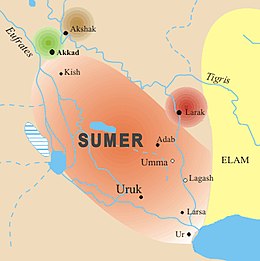| Location | Dhi Qar Province, Iraq |
|---|---|
| Region | Mesopotamia |
| Coordinates | 31°40′02″N 45°53′15″E / 31.66722°N 45.88750°E |
| Type | Settlement |
| Site notes | |
| Excavation dates | 1854, 1885, 1999-2002, 2017-2019 |
| Archaeologists | William Loftus, John Punnett Peters, Nawala Ahmed Al-Mutawalli, Drahoslav Hulínek |

Umma (Sumerian: 𒄑𒆵𒆠 ummaKI;[1] in modern Dhi Qar Province in Iraq, was an ancient city in Sumer. There is some scholarly debate about the Sumerian and Akkadian names for this site.[2] Traditionally, Umma was identified with Tell Jokha. More recently it has been suggested that it was located at Umm al-Aqarib, less than 7 km (4.3 mi) to its northwest or was even the name of both cities.[3][4] One or both were the leading city of the Early Dynastic kingdom of Gišša, with the most recent excavators putting forth that Umm al-Aqarib was prominent in EDIII but Jokha rose to preeminence later. The town of KI.AN was also nearby.[5] KI.AN, which was destroyed by Rimush, a ruler of the Akkadian Empire. There are known to have been six gods of KI.AN including Gula KI.AN and Sara KI.AN.[6]
The tutelary gods of Umma were Sara and Ninura. It is known that the ED ruler Ur-Lumma built a temple to the god Enki-gal and one to the god Nagar-pa'e at Umma.[7]
In the early Sumerian literary composition Inanna's descent to the netherworld, Inanna dissuades demons from the netherworld from taking Shara, patron of Umma, who was living in squalor.[8]
- ^ "ORACC – Umma".
- ^ Lambert, W. G. (1990). "The Names of Umma". Journal of Near Eastern Studies. 49 (1): 75–80. doi:10.1086/373421. ISSN 0022-2968. JSTOR 544410. S2CID 162374749.
- ^ Bartasch, Vitali (2015). "On the Sumerian City UB-meki, the Alleged "Umma"". Cuneiform Digital Library Bulletin. 2. ISSN 1540-8760.
- ^ Cite error: The named reference
Almamori2014was invoked but never defined (see the help page). - ^ Marek Stępień, "The Economic Status of Governors in Ur III Times: An Example of the Governor of Umma", Journal of Cuneiform Studies, vol. 64, pp. 17–30, 2012
- ^ Peat, J. A., "An Offering - List from the Third Dynasty of Ur", Revue d’Assyriologie et d’archéologie Orientale, vol. 69, no. 1, pp. 19–22, 1975
- ^ Cite error: The named reference
Frayne2008was invoked but never defined (see the help page). - ^ "Inana's descent to the nether world". Electronic Text Corpus of Sumerian Literature. Retrieved 2021-07-22.
